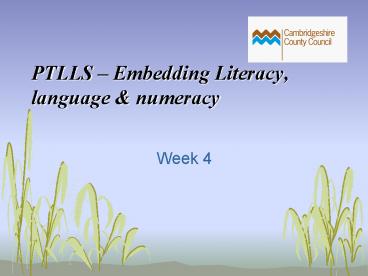PTLLS - PowerPoint PPT Presentation
1 / 14
Title:
PTLLS
Description:
... Curriculum Discuss the barriers that may be experienced when supporting LLN needs of their learners Explain ways to embed elements of LLN (Functional Skills ) ... – PowerPoint PPT presentation
Number of Views:35
Avg rating:3.0/5.0
Title: PTLLS
1
PTLLS Embedding Literacy, language numeracy
- Week 4
2
In todays session we will
- Discuss the Adult Core Curriculum associated
qualifications - Explore the opportunities available for LLN
development within classroom
3
By the end of this session you will be able to
- Describe the key components of the Adult Core
Curriculum - Discuss the barriers that may be experienced
when supporting LLN needs of their learners - Explain ways to embed elements of LLN (Functional
Skills ) within your specialist area
Level 3 2.2 (T5) - Design an activity to support/embed LLN
(Functional Skills)
4
The Adult Core Curriculum
- Also known as basic, core or essential skills
- Literacy covers abilities in
- speaking and listening
- reading and comprehension
- writing and communicating
- Numeracy covers abilities in
- understanding and using mathematical
information - calculating and manipulating mathematical
information - interpreting results and communicating
mathematical - information
5
Functional Skills
- Aim Functional skills in English, mathematics
- and ICT help people to gain the most out
- of life, learning work.
- Applying knowledge
- Competency and confidence
- Problem solving
- Levels E1 L2
6
Barriers
- In pairs think about the types of barriers that
you may encounter when supporting LLN within the
classroom. At least - 1 barrier associated with the learner
- 1 barrier associated with the tutor
- 1 barrier associated with the delivery
7
Embedded teaching and learning
- Embedded teaching and learning combines
- the development of literacy, language and
- numeracy with vocational and other skills.
- The skills acquired provide learners with the
- confidence, competence and motivation
- necessary for them to succeed in
- qualifications, in life and at work.
8
Embedded, contextualised or learning support?
- LLN learning support is usually in addition to a
workplace skills/vocational learning programme. - Contextualised LLN is primarily an LLN programme,
not a workplace skills/vocational learning
programme. - In embedded programmes, LLN learning happens
through a workplace skills/vocational learning
programme.
9
Developing LLN skills
- Developing confidence and competence
with LLN skills is therefore
a part of all learning
for all learners. - It is also a key factor to consider when
planning to include those learners who have
additional support needs with literacy, language
and numeracy skills.
10
What is embedded learning?
Embedded teaching and learning
11
The vocational contentStarting point of any
embedded learning.
- Vocational skills and knowledge
- Refers to the primary learning aims of the
learner. - Aims may be vocational, recreational or
personal. - They may lead to a qualification.
- The embedded materials also reflect the reality
of - workplace and everyday settings, using realistic
- scenarios and documentation.
12
Literacy, language and numeracy
- Literacy, language and numeracy
- These skills are clearly defined by the adult
- core curricula.
- The embedded learning materials do not set out
- to teach the whole range of literacy, language
- and numeracy outlined by the core curricula.
- The range and level of skills taught is
dictated - by the vocational content.
- Embedded learning is task-driven.
13
Think about your practice
- Does your practice allow for embedding?
- Does it occur naturally?
- When do you do it?
- Transferable skills
14
Health Safety
Listening e.g. understanding H S Information
in the workplace
Reading e.g. H S policy Law or safety data
sheets
- Skills for Life
- Health Safety
- Essential speaking listening
- 2. Understanding signs, symbols
- and key documents
- 3. Completing forms
- writing reports
Speaking e.g. providing health safety
related information to others
Writing e.g. completing accident report
details Safety audit forms































